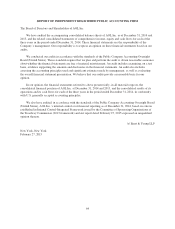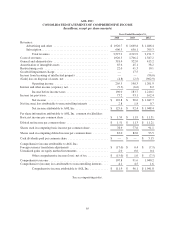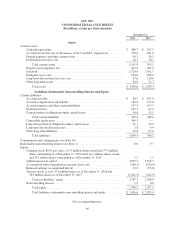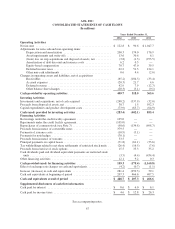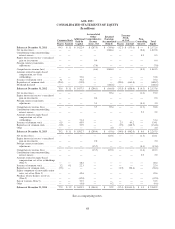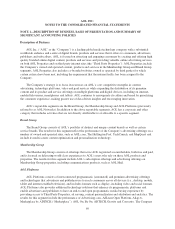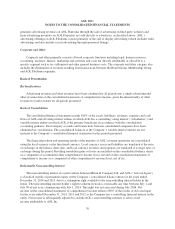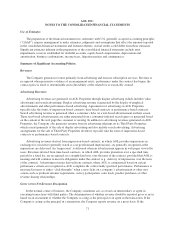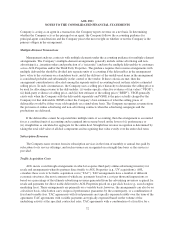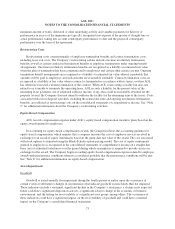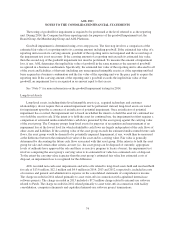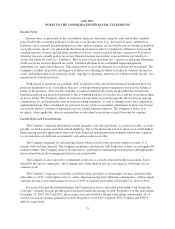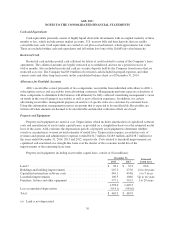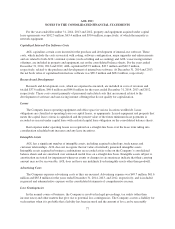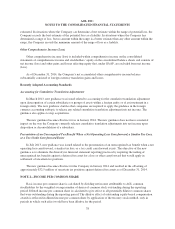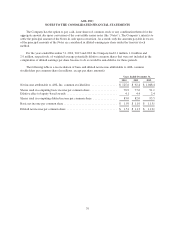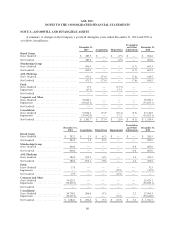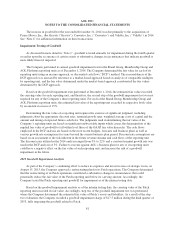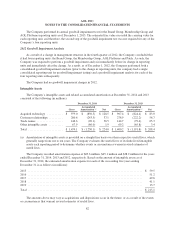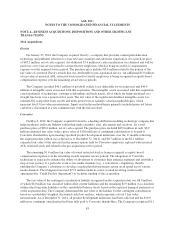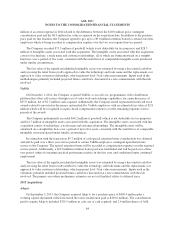America Online 2014 Annual Report Download - page 90
Download and view the complete annual report
Please find page 90 of the 2014 America Online annual report below. You can navigate through the pages in the report by either clicking on the pages listed below, or by using the keyword search tool below to find specific information within the annual report.
AOL INC.
NOTES TO THE CONSOLIDATED FINANCIAL STATEMENTS
The testing of goodwill for impairment is required to be performed at the level referred to as the reporting
unit. During 2014, the Company had three reporting units for purposes of the goodwill impairment test; the
Brand Group, the Membership Group and AOL Platforms.
Goodwill impairment is determined using a two-step process. The first step involves a comparison of the
estimated fair value of a reporting unit to its carrying amount, including goodwill. If the estimated fair value of a
reporting unit exceeds its carrying amount, goodwill of the reporting unit is not impaired and the second step of
the impairment test is not necessary. If the carrying amount of a reporting unit exceeds its estimated fair value,
then the second step of the goodwill impairment test must be performed. To measure the amount of impairment
loss, if any, AOL determines the implied fair value of goodwill in the same manner as the amount of goodwill
recognized in a business combination. Specifically, the estimated fair value of the reporting unit is allocated to all
of the assets and liabilities of that unit (including any unrecognized intangible assets) as if the reporting unit had
been acquired in a business combination and the fair value of the reporting unit was the price paid to acquire the
reporting unit. If the carrying amount of the reporting unit’s goodwill exceeds the implied fair value of that
goodwill, an impairment loss is recognized in an amount equal to that excess.
See “Note 3” for more information on the goodwill impairment testing for 2014.
Long-lived Assets
Long-lived assets, including finite-lived intangible assets (e.g., acquired technology and customer
relationships), do not require that an annual impairment test be performed; instead, long-lived assets are tested
for impairment upon the occurrence of an indicator of potential impairment. Once an indicator of potential
impairment has occurred, the impairment test is based on whether the intent is to hold the asset for continued use
or to hold the asset for sale. If the intent is to hold the asset for continued use, the impairment test first requires a
comparison of estimated undiscounted future cash flows generated by the asset group against the carrying value
of the asset group. The Company groups long-lived assets for purposes of recognition and measurement of an
impairment loss at the lowest level for which identifiable cash flows are largely independent of the cash flows of
other assets and liabilities. If the carrying value of the asset group exceeds the estimated undiscounted future cash
flows, the asset group would be deemed to be potentially impaired. Impairment, if any, would then be measured
as the difference between the estimated fair value of the asset and its carrying value. Fair value is generally
determined by discounting the future cash flows associated with that asset group. If the intent is to hold the asset
group for sale and certain other criteria are met (i.e., the asset group can be disposed of currently, appropriate
levels of authority have approved the sale and there is an active program to locate a buyer), the impairment test
involves comparing the asset group’s carrying value to its estimated fair value less estimated costs of disposal.
To the extent the carrying value is greater than the asset group’s estimated fair value less estimated costs of
disposal, an impairment loss is recognized for the difference.
AOL recorded non-cash asset impairments and write-offs related to long-lived assets held and used and held
for sale of $13.6 million, $12.1 million and $4.9 million in 2014, 2013 and 2012, respectively, included in costs
of revenues and general and administrative expense on the consolidated statements of comprehensive income.
The charge recorded in 2014 related primarily to asset write-offs in connection with capitalized internal-use
software projects. The charge recorded in 2013 included a $7.5 million charge related to internal-use software
related to Patch. The charge recorded in 2012 related primarily to asset write-offs in connection with facility
consolidation, computer retirements and capitalized internal-use software project terminations.
74


